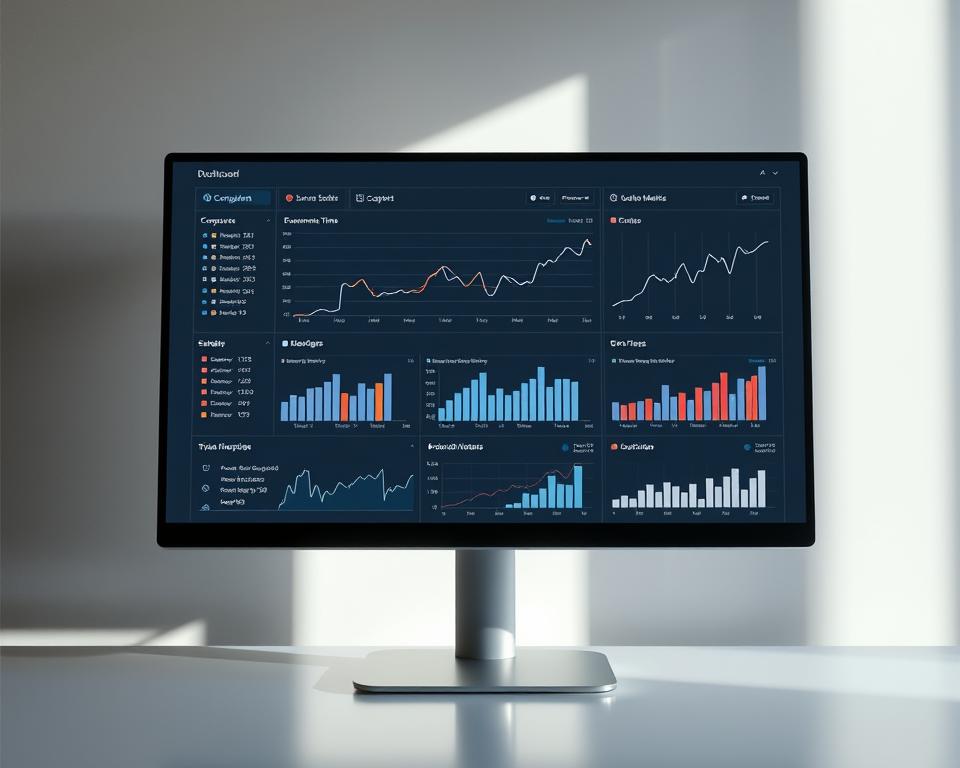Анунсиос
What if your next big win is hiding in plain sight inside the numbers?
You use data every day, but turning it into strategy is different from collecting reports. Companies that treat analytics as a core capability see clear results: one retailer grew sales 15% and cut costs 20%, while McKinsey finds organizations that harness data are far more likely to win customers and profits.
В этой статье you’ll learn how to translate raw numbers into actionable insights that lead to revenue lift, cost savings, and better customer experiences. We’ll show how descriptive, diagnostic, predictive, and prescriptive approaches answer different questions on the path from what happened to what to do next.
You’ll also get practical steps for aligning objectives, building dashboards teams actually use, and setting up an ongoing improvement loop so insights turn into measurable business success.
Why analytics matters right now for your business performance
In uncertain markets, teams that act on solid numbers move faster and with more confidence. McKinsey finds data-driven organizations are 23x more likely to acquire customers, 6x more likely to retain them, and 19x more likely to be profitable. Bain reports analytics-focused firms make decisions five times faster.
Анунсиос
That matters because faster, clearer decisions translate into real business gains. HBR notes companies using data-driven decision-making gain about 5% in productivity and 6% in profitability. Those are not abstract benefits — they change budgets, hiring, and growth plans.
- Connects analytics to growth levers with measurable outcomes
- Shortens decision cycles so teams act on evidence, not hunches
- Clarifies priorities and focuses resources where impact is highest
Итог: when you scale this capability, your organization compounds advantages quarter after quarter. Use data to inform decisions, and you’ll see clearer priorities, faster responses to trends, and steadier business growth.
From data to decisions: how you use analytics to make informed choices
Good decisions start when you turn raw numbers into clear stories that people can act on. You’ll learn to translate numbers into narratives that reduce bias by pairing context with evidence. This makes choices fair and consistent.
Анунсиос
Turning numbers into narratives: data-driven insights that reduce bias
Pair qualitative notes with quantitative measures so the whole story is visible. Use surveys and system logs to add context. Embed two-way feedback so the people behind the data help explain anomalies.
Linking KPIs to outcomes: measure impact, not just activity
Define what success looks like for each KPI. Move from tracking tasks to tracking results. Audit your metrics to avoid vanity counts and to align on real business value.
Real-time visibility for faster, smarter moves
“49% of executives say real-time analysis leads to more effective decision-making.”
Blend live alerts with weekly reviews so you react in the moment and improve over время. A financial firm using AI cut compliance issues 30% and raised client trust 15%, showing small cycles create big wins.
- Build multi-source views: CRM, HRIS, surveys, and logs to avoid blind spots.
- Set thresholds and owners so decisions trigger action with clear accountability.
- Align stakeholders on what each KPI predicts so your team can make informed decisions.
The analytics toolbox: descriptive, diagnostic, predictive, prescriptive, and beyond
Think of this toolbox as a map: each method answers a different question about your data and what to do next.
Descriptive and diagnostic: what happened and why
Descriptive summaries use charts and reports to show what happened. They set the baseline for every further step.
Diagnostic work probes causes. Use segmentation, correlation checks, and driver trees to find root causes and explain anomalies.
Predictive analytics: forecast trends and risks before they hit
Predictive analytics models historical data to forecast demand, revenue, churn, and timelines. Gartner projects 75% of organizations will deploy predictive analytics by 2025.
Apply forecasts to staffing, inventory, and risk planning so you act before trends become problems.
Prescriptive analytics: recommended actions you can trust
Prescriptive models suggest next steps — pricing changes, training, or process redesign — grounded in constraints and model outputs.
Include model governance: feature selection, validation, and bias checks. That keeps recommendations repeatable and trustworthy.
Advanced and real-time analytics: machine learning and live dashboards
Advanced analytics adds machine learning for anomaly detection and next-best-action suggestions.
Real-time dashboards give continuous monitoring so you can make minute-to-minute adjustments and seize short windows of opportunity.
- Match questions to methods to avoid overusing complex models.
- Build a roadmap from descriptive to prescriptive maturity without overwhelming teams.
- Choose analytics tools that fit purpose and integrate cleanly to avoid tool sprawl.
“Start simple, govern models, and scale only where impact is clear.”
Start with clarity: set objectives, pick KPIs, and define your data sources
Begin by naming the outcomes you need so every report maps to a business goal. This keeps work focused and helps you link daily tasks to clear goals.
Objectives that align to growth, productivity, and customer satisfaction
Step 1: set clear objectives tied to growth, productivity, and customer satisfaction. Name the outcomes you expect and who owns each one.
These objectives become your North Star for planning, resourcing, and change management.
KPIs that matter: engagement, revenue, cycle times, and quality
Step 2: choose a small set of KPIs that prove impact. Pick measures like turnover, CSAT, delivery timelines, and revenue per employees.
Document each metric with definitions, targets, and owners so interpretation stays consistent across teams and quarters.
Data sources to unify: HRIS, CRM, surveys, feedback, and usage logs
Step 3: collect and integrate from HR records, reviews, surveys, feedback tools, and product logs to create one version of truth.
- Standardize taxonomies and data models so rollups are accurate.
- Embed qualitative notes and interviews to add human context to the numbers.
- Set refresh cadences and quality checks for completeness and deduplication.
Result: you’ll translate strategy into clear objectives, choose meaningful metrics, and build reliable sources so your analytics work improves decision making and overall performance.
Bring insights to life with analytics tools and dashboards
Tools and dashboards turn raw numbers into clear, actionable signals your team can use right away. Start by choosing platforms that integrate with your stack so data flows without manual work.
Use BI platforms like Power BI or Tableau and link them to systems such as Salesforce and BambooHR. A connected setup gives you live views and a single source of truth for management decisions.
Designing simple, meaningful visualizations for leaders and teams
Prioritize clarity. Highlight exceptions, add benchmark lines, and show trend direction so leaders can act quickly.
Layer dashboards: executive overviews for strategy, functional drill-downs for managers, and team scorecards for daily work.
Reporting cadences: real-time alerts vs. weekly and monthly views
Mix real-time alerts with periodic reviews to balance speed and structure. Configure thresholds that notify owners when KPIs deviate to cut response time.
Hold daily ops huddles for urgent signals and weekly or monthly reviews to spot deeper patterns and plan improvements.
- Integrate tools—Power BI, Tableau, Salesforce, BambooHR—so data syncs automatically.
- Apply best practices: consistent scales, limited palettes, accessible design, and annotations to capture context.
- Govern dashboards—request process, usage tracking, and training to keep a single source of truth.
“Design dashboards for the question, not the data.”
Benchmarking and comparative analysis to track progress over time
To improve, you must compare — to the market, to peers, and to your own history. Benchmarks give context so your numbers are not just noise.

Industry and peer benchmarks to spot gaps and advantages
Define your benchmark set: industry medians, peer cohorts, and top-quartile leaders. That helps you see what great performance looks like in your market.
Compare service levels, costs, and quality to prioritize where changes will yield the biggest gains. Use cohort analysis to track how different customer groups behave over time.
Historical comparisons to reveal patterns and seasonality
Compare current metrics to your past to surface seasonality, cycles, and structural shifts. Rolling averages and year-over-year views separate trend from noise.
Decompose gaps into drivers like product mix, pricing, channel, or customer segments so your next steps are focused and testable.
- Identify leading indicators that precede outcomes (engagement before retention, pipeline health before sales).
- Align benchmarks with target-setting so goals are ambitious yet realistic given market conditions.
- Review source methodology to ensure valid comparisons and then convert insights into action: process fixes, capacity shifts, and measured follow-ups.
“Benchmarks turn data into direction.”
Diagnose, prioritize, act: your step-by-step improvement loop
Fixing gaps in outcomes begins with a clear, repeatable loop of diagnosis and action. You detect a problem, find the cause, test a fix, and measure results.
Root cause analysis: the 5 Whys and driver trees
Use the 5 Whys to peel back layers until you find the true cause. Pair that with driver trees to map contributing factors and quantify their impact.
Document causes—training, communication, and resource gaps—so fixes target the real constraint, not a symptom.
Identify trends and patterns across teams, time, and tools
Combine quantitative checks with qualitative feedback from your team to validate hypotheses and avoid false positives.
Analyze trends by cohort, location, and tool so you can separate localized problems from system-wide patterns.
Action plans with owners, timelines, and success metrics
Prioritize actions using impact vs. effort. Assign an owner, set clear goals, and pick leading and lagging metrics to track progress.
- Run controlled experiments where possible to prove causality before scaling.
- Keep transparent tracking so management and stakeholders stay aligned.
- Schedule retrospectives and codify playbooks so gains persist in processes and training.
“A repeatable loop turns alerts into long-term improvement.”
Analytics drive performance: tools, integrations, and scalability
Your tool choices determine how fast insights flow from raw data to action.
Choose tools that fit use cases and integrate cleanly. Define evaluation criteria: integrations, governance, TCO, and roadmap. Prioritize platforms like Power BI or Tableau that link to Salesforce and BambooHR so you avoid siloed views.
Choosing the right analytics tools for your stack
Pilot a new tool with a small group to test data fidelity and time-to-insight. Automate ingestion, cleansing, and validation so your reports stay reliable without manual work.
Integrations that remove silos and support growth
Design integrations using APIs and ETL/ELT to centralize data while keeping lineage intact. Plan for growth with architectures that scale in volume, users, and new sources.
- Standardize semantic layers and metadata so definitions stay consistent.
- Monitor pipeline health and data freshness to keep dashboards trusted.
- Set access controls and roles so the right people see the right data.
Measure adoption and impact, prune redundant tools, and balance build vs. buy based on speed to value and long-term management of processes.
Build capability: train your team and nurture a data-driven culture
Building capability means teaching practical skills, not just handing out reports. You want employees who ask better questions and read charts without guessing.
Data literacy and visualization skills for everyday decisions
Assess current skills and design clear training paths in data literacy, visualization, and basic statistics tailored to roles. Coach your team to interpret charts and spot bias so decisions improve.
Continuous feedback and transparency to increase adoption
Promote transparency by sharing methodologies, definitions, and limits so stakeholders trust outputs. Encourage two-way feedback so users report issues and suggest fixes.
- Training: role-based paths and dashboard tours to ramp new employees fast.
- Rituals: weekly reviews, show-and-tells, and office hours to normalize use.
- Community: a practice group where analysts and business users share wins and practices.
- Incentives: align rewards so the team benefits from using insights, not just making reports.
Measure progress with engagement surveys and usage metrics, then iterate on enablement so your analytics work improves business performance over time.
Trust by design: data quality, privacy, and security foundations
Trust begins with clear rules about who owns and fixes your numbers. When ownership is clear, you reduce confusion and speed fixes.
Data accuracy: cleansing, validation, and governance
You’ll implement automated cleansing and validation rules so data stays accurate and consistent.
Formalize governance with named owners, a data dictionary, and change-control processes so definitions don’t drift.
Institute regular quality reviews and remediation SLAs so issues are fixed fast and visibly.
Privacy and compliance: CCPA, GDPR, and role-based access
Enforce privacy by design to align with GDPR and CCPA. Minimize access to sensitive employee fields.
Apply role-based access and least-privilege principles so users get what they need without extra risk.
Security basics: encryption, monitoring, and incident response
Encrypt data in transit and at rest, monitor for anomalies, and keep a tested incident response plan.
Audit third-party tools for their security posture and data handling so your ecosystem stays secure.
- Вы будете document processing purposes and retention schedules to reduce liability.
- You’ll create transparency about how user data is used to build trust and participation.
- You’ll treat trust as a product feature—without it, adoption and real-world impact lag.
“Trustworthy foundations let your team move from numbers to results with confidence.”
Prove the impact: measure performance and ROI from analytics
Showing clear returns is how you turn projects into sustained investment. You’ll show concrete results by linking work to revenue, retention, and efficiency.
Outcome metrics: revenue lift, churn reduction, productivity gains
Define simple outcome metrics you can trust. Track revenue lift and sales influenced by features like recommendation engines — Amazon reports roughly 35% of sales come from its recommendations.
Measure churn reduction and productivity improvements. HBR finds data-driven companies are about 5% more productive and 6% more profitable. Those numbers help justify ongoing investment.
Decision velocity: faster cycle times and fewer compliance issues
Quantify faster approvals and shorter cycle times. Deloitte shows organizations that use analytics make decisions about 2.5x faster.
Capture reduced risk too. One financial firm cut compliance issues 30% and raised client trust 15% using AI insights. These are tangible signs of success and higher customer satisfaction.
- Attribution: use test-and-control, time-series, and contribution modeling to isolate impact.
- Value: calculate payback periods and run-rate savings to sustain funding.
- Story: publish a living ROI dashboard and short case stories so teams see real results.
“Measure the outcomes that make leaders act, and you’ll earn the runway to scale.”
Overcoming common challenges on your analytics journey
Challenges in handling data and people often matter more than the tools you pick. You’ll face issues like overload, slow adoption, and gaps in skills. The good news: small, tactical fixes deliver visible results fast.
Beating data overload with focused KPIs and clear ownership
Cut metrics to the ones that guide your core goals. Narrow KPIs to decision-critical measures and assign an owner for each one.
Sunset unused reports and set a cadence to review what stays. This reduces noise and helps teams make informed choices quickly.
Reducing resistance with quick wins and stakeholder buy-in
Start with pilots that show immediate value. Share short case stories that highlight impact and secure leadership sponsorship.
Visible wins build trust and lower resistance from employees and managers.
Bridging the talent gap with training and augmented analytics
Invest in targeted training and hire for key roles where needed. Augmented tools let less-expert users get insights while you grow internal skills.
Combine governance, validation, and automation so data quality improves as capability scales.
- You’ll mitigate privacy and security risks with compliance frameworks and minimal access controls.
- You’ll prevent tool sprawl by rationalizing platforms and standardizing integrations.
- You’ll keep your roadmap flexible, iterate with pilots, and celebrate wins to build momentum.
“Solve for clarity first: clear owners, clear KPIs, and clear stories.”
Заключение
The real test is whether insights change everyday choices across teams. Embed a clear approach so data becomes part of routines and meetings, not extra work.
You’ll leave with steps to link objectives, KPIs, dashboards, and improvement loops. That sequence turns analysis into repeatable wins that support growth and adapt to market shifts.
Invest in culture, skills, and governance so your measures stay trustworthy and useful. Keep metrics simple, protect privacy, and measure ROI as you scale.
When teams use analytics and data for data-driven decision-making, you create transparency, accountability, and lasting momentum toward better performance.



